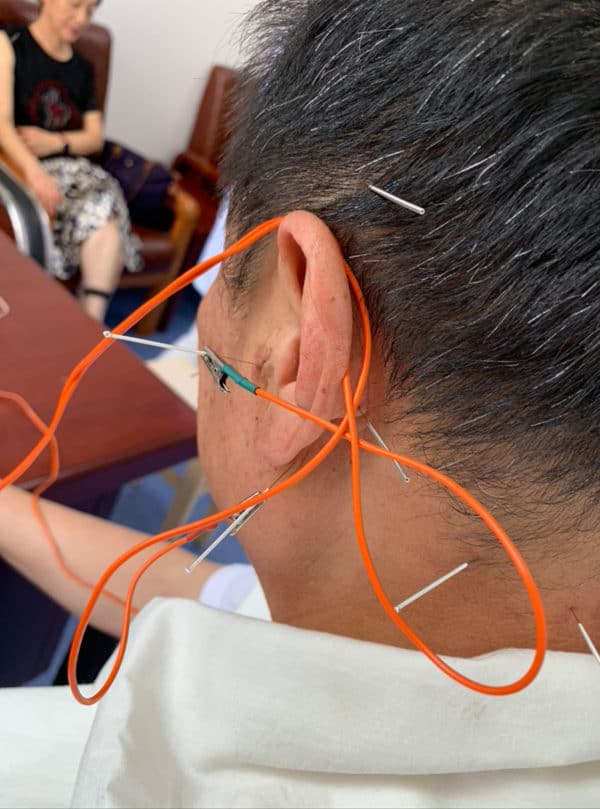
A patient receiving Acupuncture for stroke recovery
The effect of acupuncture in stroke rehabilitation may be better demonstrated when a subgroup of people with a specific type of stroke impairment is the target [18]. Existing clinical data, empirical studies, and anecdotal evidence have suggested that acupuncture may release spasticity in individuals after stroke [19-24]. Recent studies indicated that muscle spasticity occurs in only a portion of stroke survivors [25-27]. Acupuncture treatment may be used in this subgroup of stroke survivors to reduce muscle spasticity and probably further improve motor function if used in combination with a motor training program.
Muscle weakness is common and has been shown to be a more disabling factor in stroke survivors than spasticity [28-30]. Some past studies have reported a positive effect of strengthening exercises in stroke rehabilitation [31-33]. A combination of acupuncture treatment and strength training may be a better treatment option for stroke survivors with both muscle weakness and spasticity. The question is whether or not acupuncture treatment can result in additional benefit to individuals’ motor function when combined with a strength training program.
The purpose of this study was to assess the effect of combined acupuncture and strength training treatment (AS) in a group of chronic stroke survivors based on clinical and quantitative measurements of motor function.
All subjects participated in a crossover design of two types of treatment: AS and strength training treatment (S) alone. Each treatment lasted for a total of 6 weeks, with two treatment sessions a week on two different days. The order of the two treatments was randomly assigned. The AS phase consisted of 40 minutes of electroacupuncture treatment and 30 minutes of strengthening exercises. The S phase included only the strengthening exercises.
The electroacupuncture protocol was similar to a previous study [21] with some modifications, including two more acupressure points and a different stimulation frequency; these modifications were based primarily on the personal experience of a member of the research team who is also a licensed acupuncturist. The areas of skin selected for needling were cleaned with 75 percent alcohol.
The needles were single-use, disposable steel acupuncture needles (Seirin, OMS Medical Supplies Inc; Braintree, Massachusetts), with a diameter of 0.2 mm and a length of 60 mm. We actively inserted needles into six acupressure points on the subject’s hemiparetic arm: Hegu (LI 4), Houxi (SI 3), Waiguan (TW 5), Quchi (LI 11), Shousanli (LI 10), and Jianyu (LI 15) (Figure 1). During insertion, we perpendicularly placed the needles into all six points, forming a 90° angle with the skin surface.
The depth of needle insertion was approximately 10 mm for LI 11 and TW 5 and 15 mm for all other acupuncture points. We inserted needles into the tissue and actively passed alternating current between the closest pairs (LI 4 with SI 3, TW 5 with LI 11, LI 10 with LI 15) using a commercial electroacupuncture device (model ITO-4107, OMS Medical Supplies Inc; Braintree, Massachusetts). Next, we set current pulses at 2 Hz. Then, we increased the current intensity until patients reported the needling reaction.
Subsequently, we slightly reduced it to an unpleasant but tolerable level. The “needling reaction” is the characteristic response of a subject to acupuncture needle insertion and manipulation. The subject reports an acute, strongly aversive sensation that is restricted to the site of needle insertion. After 5–10 minutes, we slightly increased the stimulus as subjects became sensitized, then maintained it for 30 minutes. Consequently, we chose electroacupuncture over manual acupuncture to ensure consistent needle stimuli handling throughout the study.
Spasticity measurement data from two of our subjects were excluded from the data analysis due to technical problems encountered during data acquisition. The data analysis of spasticity reported here came from the remaining eight subjects. The VASRT values showed a significant (p < 0.05) change from 0.0092 ± 0.0068 to 0.0068 ± 0.0057 after the AS phase (all data presented as mean ± standard deviation unless otherwise noted). The changes in VASRT values before and after the S phase were not significant (p = 0.24), with a slight decrease in mean values from 0.0067 ± 0.0057 to 0.0058 ± 0.0033. A previous report included more details on the changes in spasticity [36].
The mean wrist extension ROM values are presented in Figure 2. The baseline value was the mean of the first measurements of all subjects. The pre-AS and post-AS were the means of measurement of all subjects before and after the combined treatment.
The pre-S and post-S were the means of measurement of all subjects before and after the strengthening treatment alone. We observed no significant difference between baseline (17.0× ± 19.2×) and pre-AS (20.2× ± 19.8×). However, post-AS (36.5× ± 30.6×) significantly differed from both baseline and pre-AS (p < 0.05). Similarly, we found no significant difference between pre-S (27.0× ± 29.1×) and post-S (28.7× ± 27.1×). Nevertheless, both pre-S and post-S significantly differed from baseline (p < 0.05). Only two subjects had observable active extensional motion in the index finger of the affected upper limb. The mean change in the extension ROM for these two subjects was 30× after the combined treatment and 0× after the strength training alone.
In conclusion, Electroacupuncture for chronic stroke in this current study showed a significant decrease in muscle spasticity and an increase in active ROM of the wrist joint and FM upper-limb motor scores after a combined acupuncture treatment and strengthening exercise intervention. The strengthening alone did not show any beneficial effect on the same subjects. It is premature to draw any firm conclusion given the limitations of this pilot study. We confidently assert that our study’s results suggest acupuncture, paired with motor training, may enhance motor function in chronic stroke survivors. Specifically, this combination could benefit those with moderate or severe muscle spasticity.
Resources
1- Electroacupuncture may help motor recovery in chronic stroke survivors: A pilot study